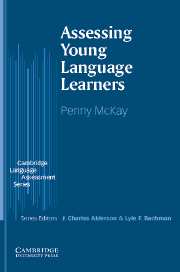Book contents
- Frontmatter
- Contents
- Series editors' preface
- Acknowledgments
- 1 A special case for young learner language assessment
- 2 Young learners and language learning
- 3 Research into the assessment of young language learners
- 4 Assessing language use through tasks
- 5 Classroom assessment of language use
- 6 Assessing oral language
- 7 Assessing reading and writing
- 8 Evaluating young learners' performance and progress
- 9 Testing young language learners through large-scale tests
- 10 The way forward
- References
- Index
- Publishers' acknowledgments
5 - Classroom assessment of language use
Published online by Cambridge University Press: 04 May 2010
- Frontmatter
- Contents
- Series editors' preface
- Acknowledgments
- 1 A special case for young learner language assessment
- 2 Young learners and language learning
- 3 Research into the assessment of young language learners
- 4 Assessing language use through tasks
- 5 Classroom assessment of language use
- 6 Assessing oral language
- 7 Assessing reading and writing
- 8 Evaluating young learners' performance and progress
- 9 Testing young language learners through large-scale tests
- 10 The way forward
- References
- Index
- Publishers' acknowledgments
Summary
Classroom assessment or teacher assessment refers to assessment carried out by teachers in the classroom. It may be formative when teachers are collecting information about children's strengths and weaknesses in order to provide feedback to learners and to make further decisions about teaching, or it may be summative, when teachers are collecting information at the end of a period of time, generally to report to others about children's progress. Summative assessment carried out by teachers may also inform their own teaching, if, for example, the learners return to them in the following school year. Formative assessment is also called assessment for learning (e.g., Black and Wiliam, 1998). Not all assessment in the classroom is classroom assessment. If teachers are administering tests in the classroom prepared by others, this is not considered to be classroom assessment because it is not prepared by the teacher but by others who are at least one step, and maybe many steps, removed from the learners and the learning situation of the classroom.
Teachers have opportunities to adopt performance assessment in its widest sense in the classroom, engaging children as active participants in assessment processes, assessing processes as well as products, collecting multiple sources of evidence over time, and working with parents and others in a collaborative assessment process. In classrooms there are many opportunities for assessment through language use tasks, when children are able to engage in language use in games, information gap oral tasks, story writing, question-and-answer tasks related to literature, project work and so on.
- Type
- Chapter
- Information
- Assessing Young Language Learners , pp. 140 - 175Publisher: Cambridge University PressPrint publication year: 2005



